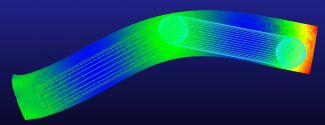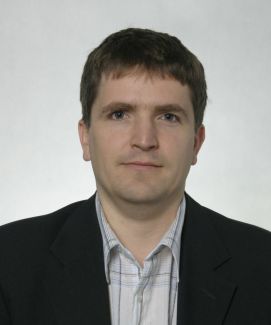An extended range endoscope, which is being developed at the Faculty of Mechanical Engineering of Lodz University of Technology, will assist doctors in treating the digestive system. The innovativeness and applications of the device are outlined below by Łukasz Frącczak, BEng, MSc, PhD, from the Institute of Machine Tools and Production Engineering, Lodz University of Technology.
You are currently developing an extended range endoscope. What possibilities does it offer to both doctors and patients in digestive system diagnosis?
Together with a team of young researchers at Lodz University of Technology, we are now developing a device that will help doctors treat their patients. It is an endoscope that will allow doctors to diagnose the entire digestive system, as well as examine a patient during one visit. At the moment, if the causes of a disease are not detected during traditional colonoscopic and so-called “gastroscopic” examinations, patients have to undergo other examinations, e.g. abdominal ultrasonography or computed tomography. In Poland, patients have to queue to be given such further examinations, sometimes even for many months. The diagnostic process may take as long as a year, or even up to 3 years in some cases, while the disease keeps on developing and destroying the human body. It is also true that doctors decide to treat their patients the way they consider to be best in such situations, as they cannot leave the patients without any emergency medical treatment. It is as if someone was trying to “drive a car with their eyes closed”. By developing our device, we want to let doctors “see”, so that it is possible for them to apply a suitable medical treatment procedure as soon as possible. Therefore, the benefits for both doctors and patients are obvious and can be briefly summarized as: being able to start treating patients with digestive diseases faster, applying suitable methods.
What does the tool that is being developed at the Faculty of Mechanical Engineering of Lodz University of Technology look like?
I cannot tell you much about the device itself today, as we are planning to obtain a patent for it. However, it can be generally stated that the endoscope will look like a long snake equipped with a camera and a “tool channel”. The camera will let doctors see the area in front of the device in real time, while the tool channel will enable them to use surgical tools during the examination.
Endoscopy is one of the most important types of examinations when it comes to selecting suitable treatments for patients. Why has such technology not been developed so far?

For many years, scientists have been working on technologies that will make it easier for doctors to examine the human digestive system and make diagnosis. The problem is that already available devices do not let doctors simultaneously make diagnosis and carry out surgical procedures, e.g. collect samples for histopathological examinations, remove arterial blockages, or deliver drugs directly to a given area. Capsule endoscopy is one of the diagnostic methods that are being developed most intensively nowadays. The method involves swallowing a capsule that takes photographs inside the digestive system. Unfortunately, such capsules cannot perform surgical procedures. There are also colonoscopic examinations, but their biggest disadvantage is limited range. One could name many more methods – however, none of them let doctors both make diagnosis and apply treatment within the whole digestive system, which will be made possible with the use of our invention. Why has it not been developed so far? Most probably due to the fact that other scientists have not created appropriate driving units. Researchers from the Institute of Machine Tools and Production Engineering of Lodz University of Technology have developed artificial pneumatic muscles that ensure the possibility of sufficient miniaturization and thus allow us to significantly reduce the size of the designed device. The miniaturization is really important, as it will enable doctors to insert the whole device equipped with the driving units into human intestines.
When will patients be able to use the endoscope?
We are now focusing on the details of each individual element of the device and planning to build a complete prototype next year. Patients, however, will still have to wait for 3 – 5 years. The duration of the period is connected with medical procedures and the necessity to conduct clinical trials. Before a product is launched onto the market, one needs to prove that it is safe for patients. We have been working on the project itself for a few years, while our work accelerated when we were awarded a research grant from the LIDER programme, funded by the National Center for Research and Development*.
What other medical robots are you also working on?
Our unit is also developing a measuring arm designed to support surgeons during hip replacement surgeries. We have already filed for a patent and the invention has been awarded a few prizes at international innovation fairs. Clinical trials are starting soon and the device will be launched onto the market. Unfortunately, I am not part of the team that is working on this invention, but I think it is worth mentioning here, as it can revolutionize the hip replacement procedure.
We are also developing a cardiac surgical robot called Robin Heart. It has been created in cooperation with Professor Zbigniew Religa Foundation of Cardiac Surgery Development in Zabrze. The robot is designed to assist doctors during surgeries. At the moment, we are intensively working on its functions connected with assisting a doctor at work. It is one of the first “milestones” that will let such a robot work autonomously.
It is worth being a scientist, because...
It is definitely an interesting job, as it depends on us what we are going to deal with. The best moments for a scientist are those when the devices we design start to work the way we expect them to do. The moments when we learn that we have been given funding to carry out our research are also important. Satisfaction that results from successfully completed research and projects fully compensates for the devoted time. It must also be emphasized that our work is actually done for future generations, to allow people to “live better lives”.
* Project No. LIDER/20/0106/L-7/15/NCBR/2016.
Dr inż Łukasz Frącczak, also one of the authors of the Blog of Lodz University of Technology.

